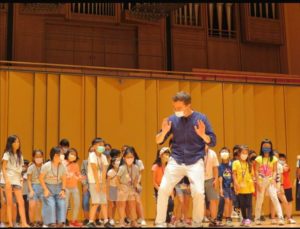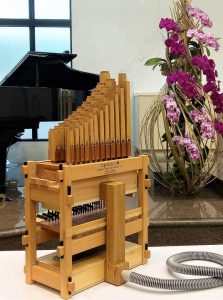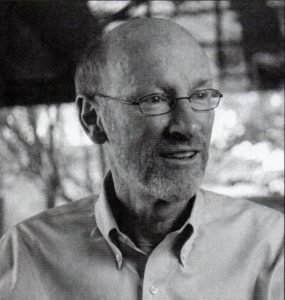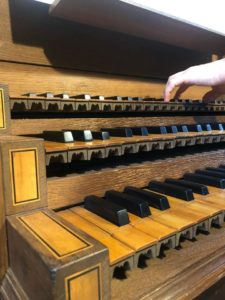Orgelkids China執行長蔣士挺(Justin Berg)「兒童管風琴教育專欄」【初因初音】。
『Aristide Cavaille-Coll, part II』from the column【My First Sound】 by Justin Berg, the Executive Director of Orgelkids China. (In English below)
卡發耶科爾不但重新想像簧管的配置,還有許多創新和構想也造就出他出色的製琴生涯,這些特色可見於巴黎北邊的聖德尼大教堂裡的大管風琴,也就是他最早的重要管風琴作品。這座教堂是第十世紀以來法國王室成員的長眠之地,教堂建築本身是一座廣闊雄偉的中世紀建物,並且被視為最早的歌德式完整建築之一。卡發耶科爾搬到巴黎時才24歲,因為義大利作曲家Giocomo Rossini對於他早期的創新發明相當讚賞,催促他一定要去巴黎。
卡發耶科爾一抵達巴黎,便得知聖德尼教堂的新管風琴設計競賽正在進行,而且即將截止,於是他迅速地在兩天當中做出一份提案。他新穎的想法說服了多位評審,因而得到這份合約。他的設計裡有一些非常吸引人的細節,包括用新式的音栓來模仿管弦樂團的聲音,例如8呎雙簧管音栓(一種和真正的英國管同樣有球莖狀共鳴體的音栓),也包含可以製造出強有力變化的全音域調量鍵盤。此外,他的音栓組合強調8呎的基礎音色 (foundation sound),將風室分隔成各個不同氣壓的區域,以不同的風壓供氣給笛管和簧管。他也提供了用腳操作的活塞,這個機械裝置可以控制簧管的氣流。(請參考我相機中珍藏的相片,在St. Denis的管風琴廂樓,欣賞法國管風琴樂派即興大師,風趣慧黠的駐堂管風琴師 Pierre Pincemaille,彈奏這台卡發耶科爾早期最重要、最初嶄露鋒芒的歷史名琴)。
上述的各種創新設計,使得卡發耶科爾後來被公認為創意十足的天才管風琴建造家,不過也為這個年輕的天才帶來一個嚴重的問題:增強的風壓、大量的規格設定,再加上觸鍵的傳動裝置,導致鍵盤太重而難以持續演奏。所幸卡發耶科爾得到天時地利人和,在最需要突破的時刻,他認識了來自英國的Charles Spackmann Barker,Barker擁有一項特殊裝置的法國專利(於1839年註冊),就是在機械傳動中加入氣動的輔助,以此緩和按鍵太重的問題。Barker宣稱是這項裝置的正牌發明者,有人質疑這樣的說法(也質疑他的工藝才能),但我們可以確定的是,Barker授權給卡發耶科爾,讓他從聖德尼教堂的管風琴建造開始運用這項專利。於是卡發耶科爾就能夠建造出極為龐大卻還能演奏的管風琴,他的第一個大型設計案也很幸運地沒有淪落成廢墟。
這樣的規格有幾個值得注意的地方。前面介紹過,卡發耶科爾繼承了法國古典傳統,所以現在要舉出他在聖德尼教堂的這部早期傑作的傳統特點。首先,手鍵盤(54個按鍵)和腳鍵盤(25個按鍵)的音域仍保有18世紀管風琴的特點,典型的音栓齊奏(主音管合奏)維持不變,手鍵盤有32個主音管(從低音F開始),一路延伸到四個混合音栓,製造出非常宏大的音響效果。而整批的加倍簧管音響更是雄偉,雖然仍是古典風格:每個獨立風琴都有8呎燦爛簧管,主風琴、蓬巴德音管和腳鍵盤也都有第一和第二燦爛簧管和法國小喇叭。(待續)
你的朋友蔣士挺
〜Cavaille-Coll (Part II)–2
Just as with his reimagining of reed work, many of the innovations and ideas that would shape Cavaille-Coll’s career can be found in his first major instrument, the Grand Orgue at the Basilica of St. Denis, north of Paris. The burial place of French monarchs from the 10thcentury, St. Denis is a vast Medieval edifice, considered to be one of the first fully Gothic expressions of architecture. Aristide was a mere 24 years old when he moved to Paris, at the urging of the Italian composer, Giacomo Rossini, who had been impressed by one of Aristide’s early inventions.
Upon his arrival in the French capitol, Aristide learned that a competition was being held for the design of a new grand organ for St. Denis. Because the competition was about to conclude, Aristide worked swiftly to produce a proposal in just two days. His novel ideas convinced the judges, and thus he was awarded the contract. Some of the most intriguing details of his design were new stops intended to imitate orchestral instruments, such as the 8’ Cor-Hautbois (a stop with bulb-shaped resonators, like those of the actual English horn), and the inclusion of a full-compass Swell division for creating dynamic changes. Additionally, his stoplist emphasized 8’ foundation sound, while placing flues and reeds on different wind pressures. This was accomplished by partitioning the wind chests into separate areas for different pressures. He also provided a foot-operated mechanism, a ventil, for controlling
wind to the reeds.
Taken together, these innovations would ultimately secure Cavaille-Coll’s reputation as a creative genius. However, they also posed a serious problem for the young organ builder: the increased wind pressures and generous specification combined with the tracker action to make the touch of the keys too heavy for sustained playing. Fortunately for Aristide, he happened to be in the right place at the right time. Just when he needed a breakthrough, he met an Englishman, Charles Spackmann Barker. Barker held a French patent (registered in 1839) for a special device that alleviated the problem of heavy touch by incorporating a pneumatic assist into the mechanical action. While Barker’s claim as the true inventor of this machine is sometimes disputed (as is his competence as a craftsman), what is certain is that Barker licensed his patent to Cavaille-Coll for use in his instruments, starting with the organ at St. Denis. This bit of good luck saved Aristide’s first massive project from ruin by
allowing him to build an enormous organ that still felt playable.
There are several points of interest in this specification. Since our previous article was about the Classical tradition that Cavaille-Coll inherited, we can start by noting the conventional aspects of this early masterpiece at St. Denis. First, the manual (54 notes) and pedal (25 notes) compasses remain typical of late 18th century organs. The quintessential Plein jeu (principal chorus) is more than intact, with a manual 32 Montre (which only began at bass F), all the way up through four mixtures — a grand sound, indeed! Grander still, yet Classical, are the batteries of reduplicated reeds: 8’ Trompette in every division, as well as first and second Trompette and Clarion in the Grand Orgue, Bombarde and Pédale. (To be continued)
Your Friend,
Justin





